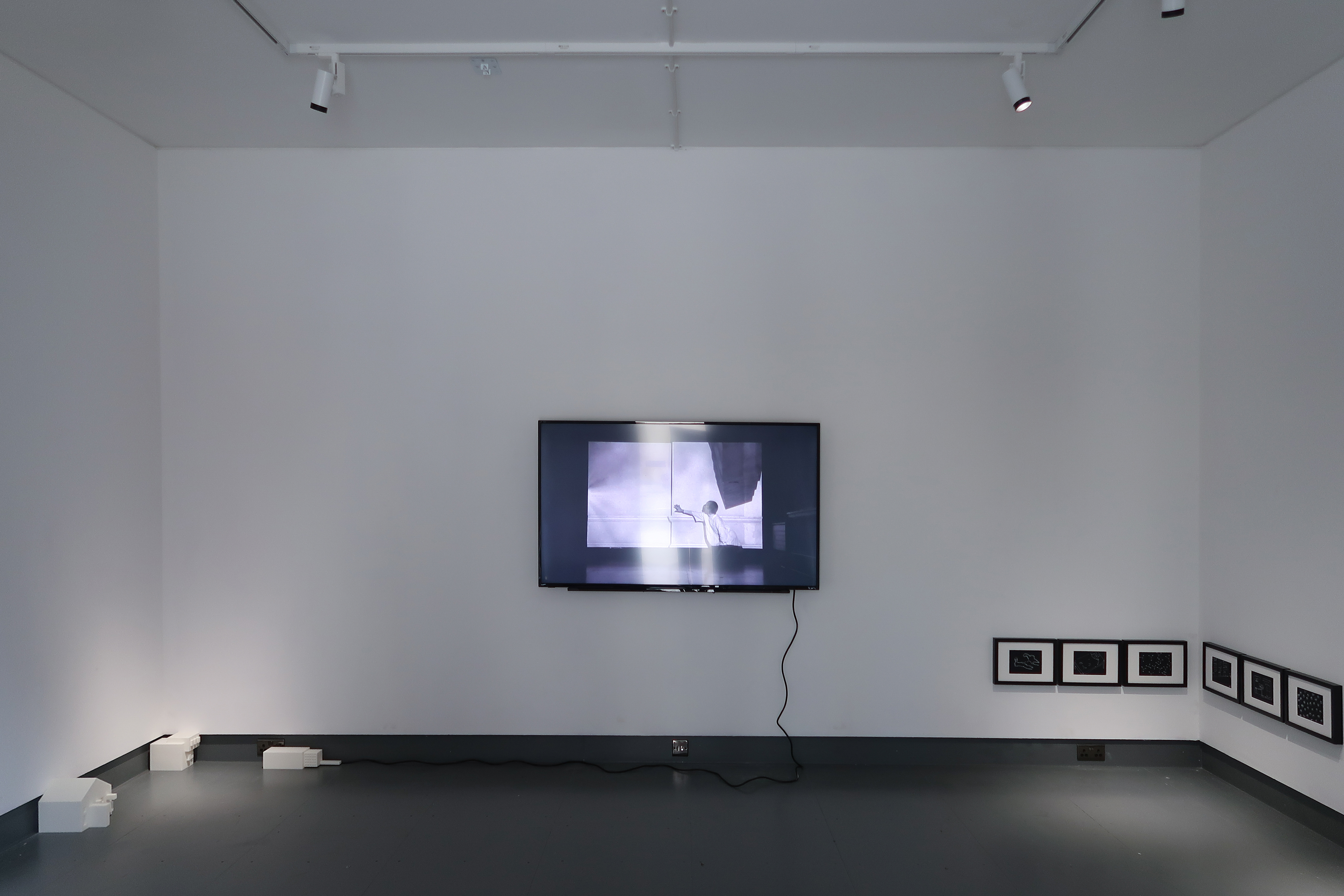
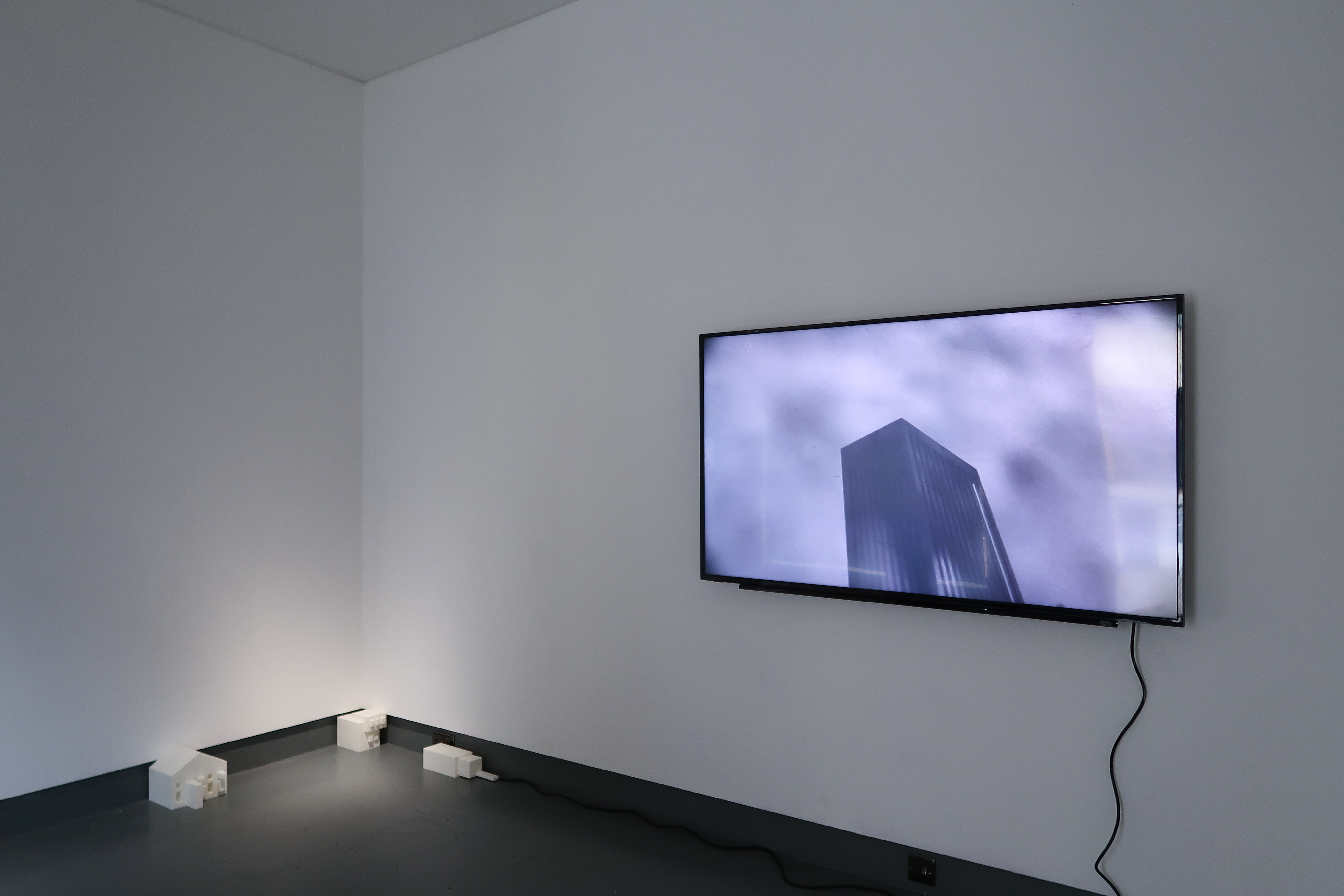
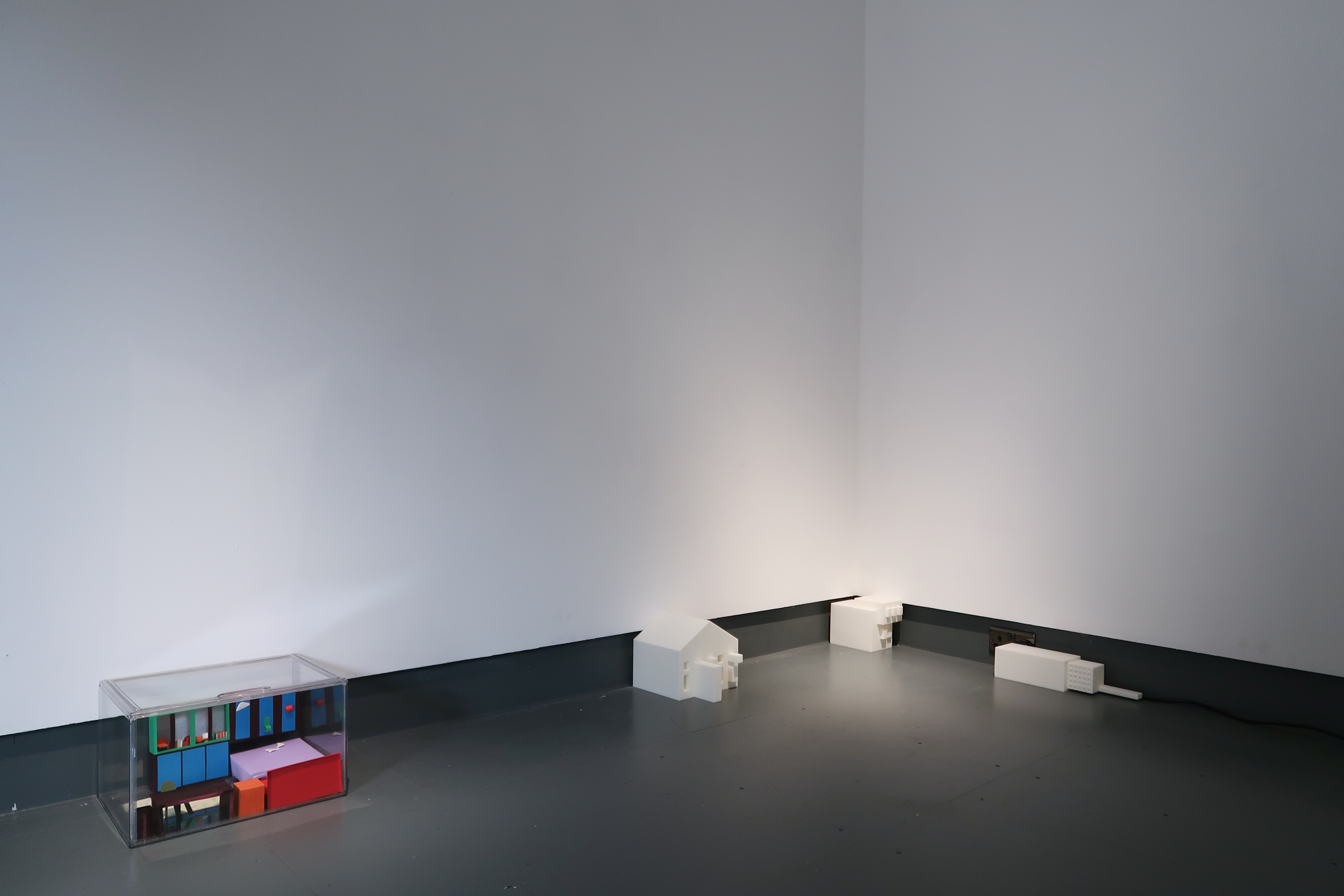


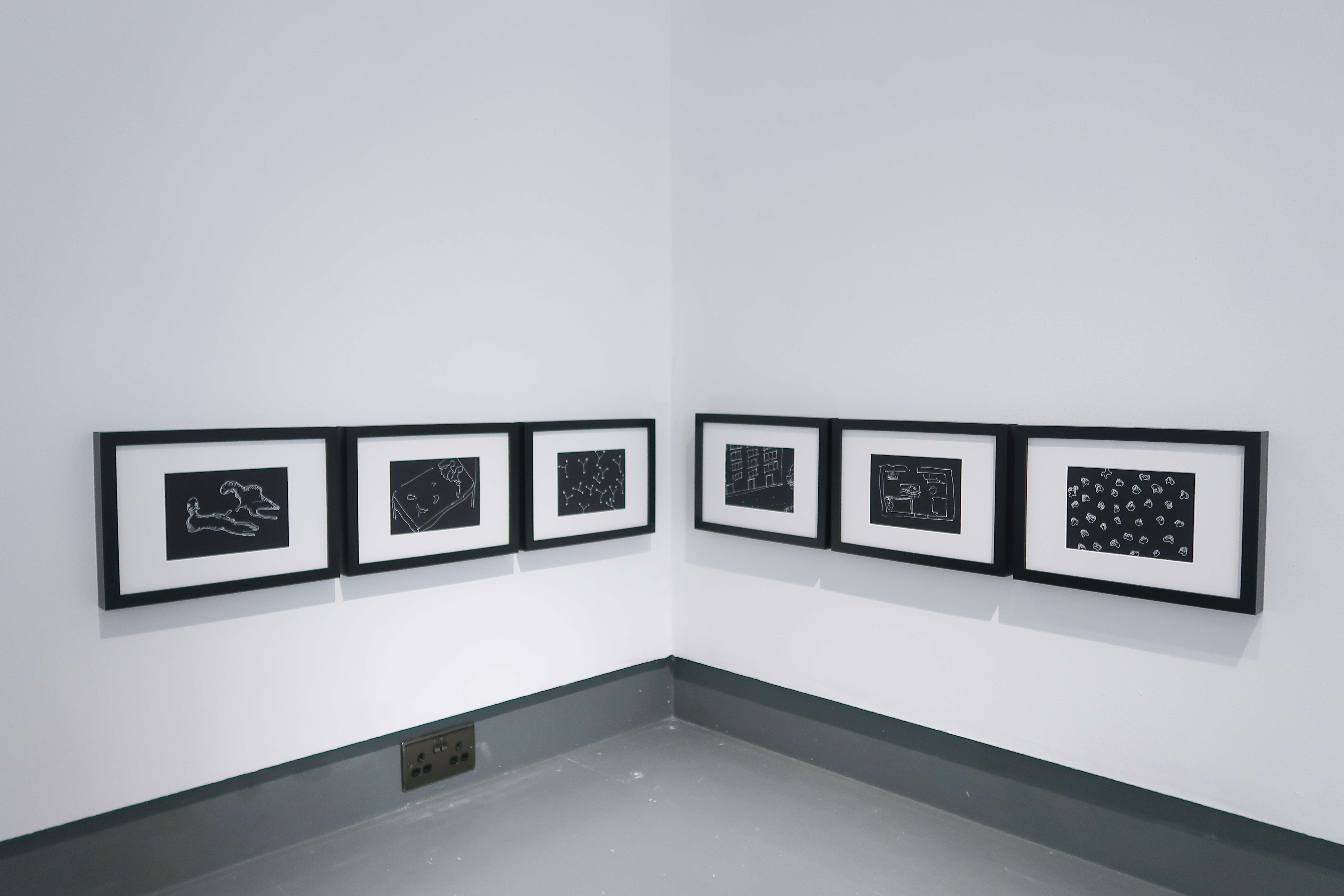
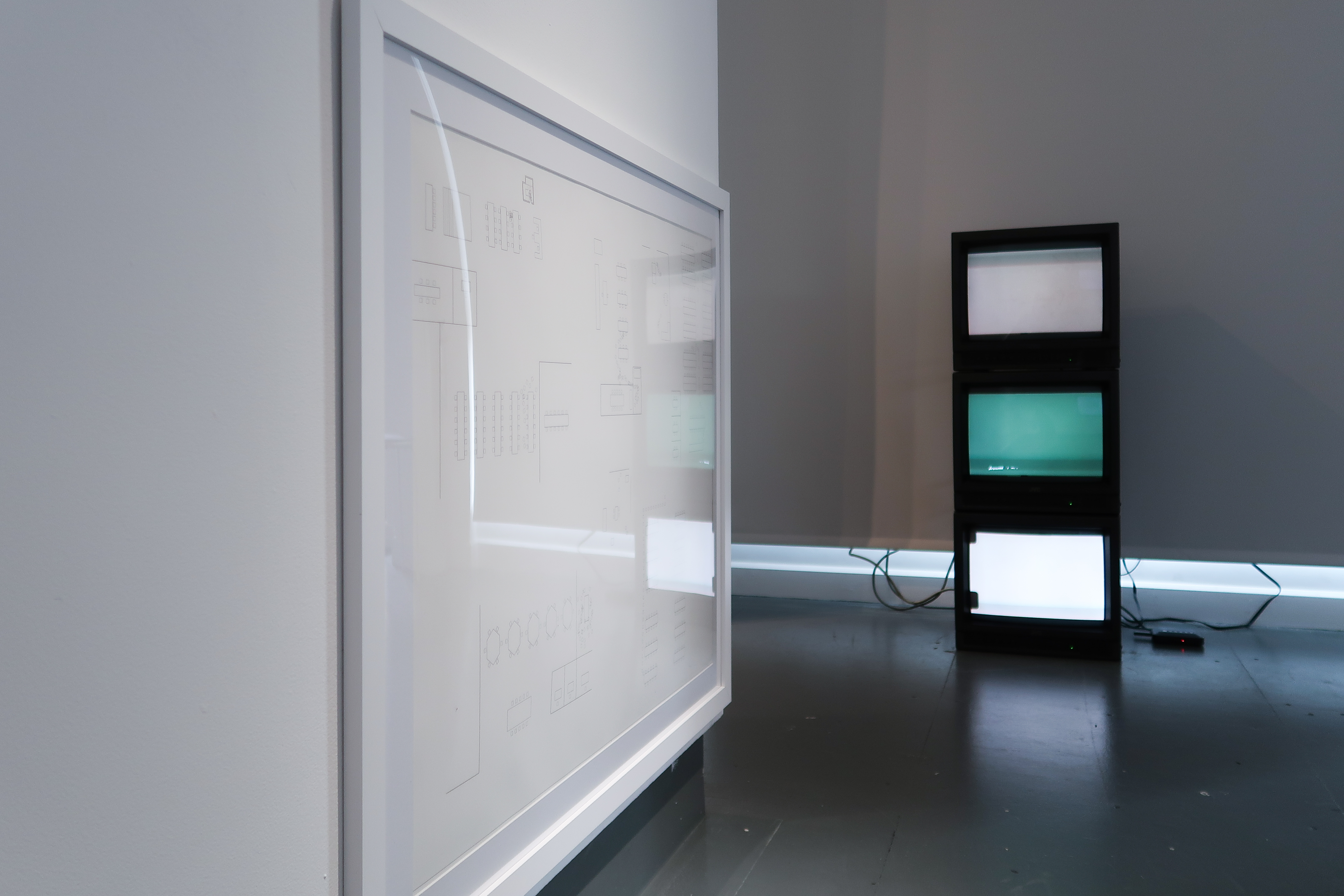

Licking, Weeping, Baying
Chris Zhongtian Yuan, solo
Tabula Rasa Gallery | London
06 March - 17 April, 2024
Chris Zhongtian Yuan, solo
Tabula Rasa Gallery | London
06 March - 17 April, 2024
Tabula Rasa Gallery is delighted to present Chris Zhongtian
Yuan’s first gallery solo show in London, Licking, Weeping, Baying. Opening
on the 6th of March at
our gallery space in London, the exhibition offers a thorough exploration of the
artist’s practice, following his current participation at the group show CUTE in Somerset House, London. Accompanying
the exhibition is an essay by Dr. Sophie Guo from the Courtauld Institute of
Art.
Licking, Weeping, Baying showcases a series of video installations, sculptures and drawings surrounding two recent films Cloudy Song (2022) and No Door, One Window, Only Light (2023) by the artist. They delve into the themes of failure, pathology, co-dependency and emotional labour within familial, institutional, and corporate contexts Set in Somerset House’s vast vaults, Cloudy Song follows a future exile's quest to recover memories aided by a somewhat ineffective "care robot". The film explores the relationship between sound and memory in the Chinese diaspora, featuring a soundtrack blending AI-generated music with original compositions by Wuhan musician Lu Yan.
Further exploring individual existence within marginalised communities, No Door, One Window, Only Light focuses on the artist's late friend, L, who passed away in 2022. This introspective video series intricately traces every connection to this significant individual, delving into themes of home, absence, trauma, and sanity. As Dr. Sophie Guo writes: “L’s return home was overshadowed by homesickness, where the home itself literally became a space of illness. Figures of homesickness are often marked by a condition of internal alterity. Politically, they frequently manifest as subjects of rebellions or uprisings, which consequently are forced into exile or relegated to a marginalised status within society. This is enforced to preserve the imagined coherence of nations, families, or bodily selves, which, in truth, should have been understood as heterogenous entities.”
The artist will also debut his latest performance during the opening evening. The new performance, titled “Intimate Labour” pays homage to Andrea Fraser’s seminal performance Official Welcome, in order to contemplate the role of performance and emotion and their nuanced implications in domestic and institutional contexts.
The research of the work is supported by Arts Council England Develop Your Creative Practice Grant.
The original text is commissioned by te editions.
Home(sickness)” (lixiang bing)
Text by Sophie Guo
‘“Homesickness” (lixiang bing) — referring to a condition caused not by a longing for home, but rather by an excessive proximity to it.’(1) In Chris Zhongtian Yuan’s 2023 three-channel video No Door, One Window, Only Light, the camera peeps through the narrow door of the artist’s handmade maquette of their childhood room, zooming in, but only becomes more out of focus. A ghostly background noise haunts the delirious and near-pathological scrutiny of the memory-image of their family home room. The sense of the uncanny, or more precisely, the unheimlich, arises not from the pervasive disorienting sensation within the moving image but rather from the dismembered and misplaced furniture that nearly constitutes a crime scene, all observed through voyeuristic apertures in the wall.
It was in this very room that the artist and their childhood friend, L, were first introduced by their parents. Growing up together in Wuhan, they embarked on their studies abroad, eventually taking separate paths and losing contact for over a decade. Upon Yuan’s return to his native city of Wuhan after several years away due to Covid-19, he learned that L had begun showing symptoms of schizophrenia after returning home from a small town outside Berlin. L battled this mental illness for 15 years, during which he was confined to his home, until his premature death in 2022. In response to the irrevocable loss of their childhood friend, Yuan engaged in a speculative letter exchange with him. Through this dialogue, they explored and challenged each other on the notions of home, futurity, memory, vulnerability, resistance, and fraught relationships.
L’s return home was overshadowed by homesickness, where the home itself literally became a space of illness. Sinologist Carlos Rojas has discovered that figures of homesickness are often marked by a condition of internal alterity. Politically, they frequently manifest as subjects of rebellions or uprisings, which consequently are forced into exile or relegated to a marginalised status within society. This is enforced to preserve the imagined coherence of nations, families, or bodily selves, which, in truth, should have been understood as heterogenous entities.(2)
The early death of L prompted Yuan to reflect on their own uneasy relationship with childhood, family, institutions, corporate environments, and society. In the third video channel, we observe the artist’s reflection, captured while holding a portable Super 8mm camera, appearing on the Apple computer screen. Here, the flickering image of a 3D printed model of their childhood room is displayed. Yuan’s meta-filmmaking process deliberately evokes the self-reflexivity characteristic of structural/materialist films from the 1960s. In the actual exhibition space of Licking, Weeping, Baying, the jail-like model, with no door, one window, is displayed on a cold metal office cabinet. The domestic space and corporate environment seem confounded; neither displays a hint of warmth.
‘I saw no future in architecture. “No Future” is not necessarily a bad thing.’ ‘What you said, I can relate. I can relate to “no future.”’ The artist writes to their imagined interlocutor.
Queer theorist Lee Edelman lamented, ‘the future is kid stuff.’ In a society where heteronormativity defines the social order, the Child is the preeminent emblem of the future, whether in terms of reproduction or productivity.(3) In Yuan’s family’s case, it was even the birth of a child that ensured the acquisition of a residence in the faculty dormitory building at the Hubei Institute of Fine Arts, as we heard the artist’s mother disclose in the video. While their mother speaks, a sequence of shots showcasing architectural models inspired by John Hejduk, created by Yuan, who was originally trained as an architect, plays. Tinged with a sense of Kafkaesque absurdity, these architectural models seem to resist the positivity of functionalism, fundamentally at odds with the notion of a modern liveable home. They appear to serve more as gestures of provocation, embodying failure and indeed, a sense of ‘no future,’ rather than as a functional design. China’s patrilineal tradition, coupled with the one-child policy that characterised the artist’s generation, has rendered queerness a site of internal alterity too. As quasi non-identity, a queer subject is an archetypal figure of profound homesickness, never at home, perpetually in exile, as they only occupy the margins of an idealised Chinese cultural tradition.
But ‘can we work with the inherent negation in identity to work towards collective resistance in our new home?’ In their twenty-minute video work Cloudy Song (2022), which features CGI images of a ghostly city with high rises reminiscent of the banal residential new-builds in Wuhan, fragments of AI-generated childhood songs, and performance footage of the post-punk singer Lu Yan, a care robot named Y attempts homemaking for an exiled human figure named M, who suffers from memory loss. Shot entirely at the old Somerset House and a tomb for the dead, with spaces demarcated solely by light and sound and permeated by a spectre, the film is imbued with an ultimate sense of unhomeliness. This setting propels the uncanny into the even more unsettling realm of the death drive.(4) Considering the collective memory that the robot sourced from his family members and their friends as ‘foreign,’ M’s amnesia uproots him from his birthplace. His individual estrangement mirrors the societal alienation that ultimately leads to his exile. The estranged urban environment, hauntingly presented in the film, implies that rampant urbanisation, driven by the combined forces of political power and real estate developers, devours the once-familiar childhood spaces shared by local communities.
A background story could involve the grassroots defence of Eastlake by artists, punk musicians, and activists against the aggression of developers backed by local authorities. A Youth Autonomous Centre, named ‘Our Home,’ became a semi-public space for nomadic gatherings, co-living, and exhibitions shared by these anarchists. It serves as an alternative model of art and activism to developer-led-art-institutions. An equalitarian model of ‘direct democracy’ was adopted in the process of reclaiming public space through mythmaking, parafiction, and participatory creative practices. However, faced with government crackdowns, censorship measures, and capitalist expansion, ‘Our Home’ only existed from 2008 to 2016. The once revolutionaries have gone missing, becoming ghosts who recede into liminal spaces and have lost their home. But it is not devoid of light. Though the ghosts are out of place, they are now able to claim any site as their virtual home. The iteration of the revolutionary ghost, unbound by a fixed identity, possesses the fluidity to morph, transform, and flow like water. This adaptability not only upholds a legacy of anarchist alterity but also propels continuous and dynamic transformations.
Notes
(1)Rojas, Carlos. Homesickness: Culture, Contagion, and National Transformation in Modern China (Cambridge, Massachusetts: Harvard University Press, 2015), vii. Original emphasis.
(2)Rojas, ix.
(3)Edelman, Lee. No Future: Queer Theory and the Death Drive (Durham: Duke University Press, 2004), 13.
(4)This is informed by Anthony Vidler. See The Architectural Uncanny: Essays in the Modern Unhomely (Cambridge, Mass.: MIT Press, 1999), 7.
About the artist:
Chris Zhongtian Yuan (b.1988, lives and works in London) holds a master’s degree from the Architecture Association School of Architecture (London). He is currently pursuing a Ph.D. in Fine Art at Kingston School of Art (London). Yuan’s works have been extensively featured in institutional exhibitions worldwide, including the Times Museum (Guangzhou, China), Somerset House (London, UK), Reading International (Reading, UK), Macalline Art Centre (Beijing, China), V.O Curations (London, UK), and K11 (Wuhan, China). Additionally, Yuan has participated in screenings and performances at the San Diego Asian Film Festival (California, US, 2023), the International Film Festival Rotterdam (Rotterdam, the Netherlands, 2023), the B3 Biennial of the Moving Image (Frankfurt, Germany, 2022), Whitechapel Gallery (London, UK, 2022), the Power Station of Art (Shanghai, China, 2021), among others
Licking, Weeping, Baying showcases a series of video installations, sculptures and drawings surrounding two recent films Cloudy Song (2022) and No Door, One Window, Only Light (2023) by the artist. They delve into the themes of failure, pathology, co-dependency and emotional labour within familial, institutional, and corporate contexts Set in Somerset House’s vast vaults, Cloudy Song follows a future exile's quest to recover memories aided by a somewhat ineffective "care robot". The film explores the relationship between sound and memory in the Chinese diaspora, featuring a soundtrack blending AI-generated music with original compositions by Wuhan musician Lu Yan.
Further exploring individual existence within marginalised communities, No Door, One Window, Only Light focuses on the artist's late friend, L, who passed away in 2022. This introspective video series intricately traces every connection to this significant individual, delving into themes of home, absence, trauma, and sanity. As Dr. Sophie Guo writes: “L’s return home was overshadowed by homesickness, where the home itself literally became a space of illness. Figures of homesickness are often marked by a condition of internal alterity. Politically, they frequently manifest as subjects of rebellions or uprisings, which consequently are forced into exile or relegated to a marginalised status within society. This is enforced to preserve the imagined coherence of nations, families, or bodily selves, which, in truth, should have been understood as heterogenous entities.”
The artist will also debut his latest performance during the opening evening. The new performance, titled “Intimate Labour” pays homage to Andrea Fraser’s seminal performance Official Welcome, in order to contemplate the role of performance and emotion and their nuanced implications in domestic and institutional contexts.
The research of the work is supported by Arts Council England Develop Your Creative Practice Grant.
The original text is commissioned by te editions.
Home(sickness)” (lixiang bing)
Text by Sophie Guo
‘“Homesickness” (lixiang bing) — referring to a condition caused not by a longing for home, but rather by an excessive proximity to it.’(1) In Chris Zhongtian Yuan’s 2023 three-channel video No Door, One Window, Only Light, the camera peeps through the narrow door of the artist’s handmade maquette of their childhood room, zooming in, but only becomes more out of focus. A ghostly background noise haunts the delirious and near-pathological scrutiny of the memory-image of their family home room. The sense of the uncanny, or more precisely, the unheimlich, arises not from the pervasive disorienting sensation within the moving image but rather from the dismembered and misplaced furniture that nearly constitutes a crime scene, all observed through voyeuristic apertures in the wall.
It was in this very room that the artist and their childhood friend, L, were first introduced by their parents. Growing up together in Wuhan, they embarked on their studies abroad, eventually taking separate paths and losing contact for over a decade. Upon Yuan’s return to his native city of Wuhan after several years away due to Covid-19, he learned that L had begun showing symptoms of schizophrenia after returning home from a small town outside Berlin. L battled this mental illness for 15 years, during which he was confined to his home, until his premature death in 2022. In response to the irrevocable loss of their childhood friend, Yuan engaged in a speculative letter exchange with him. Through this dialogue, they explored and challenged each other on the notions of home, futurity, memory, vulnerability, resistance, and fraught relationships.
L’s return home was overshadowed by homesickness, where the home itself literally became a space of illness. Sinologist Carlos Rojas has discovered that figures of homesickness are often marked by a condition of internal alterity. Politically, they frequently manifest as subjects of rebellions or uprisings, which consequently are forced into exile or relegated to a marginalised status within society. This is enforced to preserve the imagined coherence of nations, families, or bodily selves, which, in truth, should have been understood as heterogenous entities.(2)
The early death of L prompted Yuan to reflect on their own uneasy relationship with childhood, family, institutions, corporate environments, and society. In the third video channel, we observe the artist’s reflection, captured while holding a portable Super 8mm camera, appearing on the Apple computer screen. Here, the flickering image of a 3D printed model of their childhood room is displayed. Yuan’s meta-filmmaking process deliberately evokes the self-reflexivity characteristic of structural/materialist films from the 1960s. In the actual exhibition space of Licking, Weeping, Baying, the jail-like model, with no door, one window, is displayed on a cold metal office cabinet. The domestic space and corporate environment seem confounded; neither displays a hint of warmth.
‘I saw no future in architecture. “No Future” is not necessarily a bad thing.’ ‘What you said, I can relate. I can relate to “no future.”’ The artist writes to their imagined interlocutor.
Queer theorist Lee Edelman lamented, ‘the future is kid stuff.’ In a society where heteronormativity defines the social order, the Child is the preeminent emblem of the future, whether in terms of reproduction or productivity.(3) In Yuan’s family’s case, it was even the birth of a child that ensured the acquisition of a residence in the faculty dormitory building at the Hubei Institute of Fine Arts, as we heard the artist’s mother disclose in the video. While their mother speaks, a sequence of shots showcasing architectural models inspired by John Hejduk, created by Yuan, who was originally trained as an architect, plays. Tinged with a sense of Kafkaesque absurdity, these architectural models seem to resist the positivity of functionalism, fundamentally at odds with the notion of a modern liveable home. They appear to serve more as gestures of provocation, embodying failure and indeed, a sense of ‘no future,’ rather than as a functional design. China’s patrilineal tradition, coupled with the one-child policy that characterised the artist’s generation, has rendered queerness a site of internal alterity too. As quasi non-identity, a queer subject is an archetypal figure of profound homesickness, never at home, perpetually in exile, as they only occupy the margins of an idealised Chinese cultural tradition.
But ‘can we work with the inherent negation in identity to work towards collective resistance in our new home?’ In their twenty-minute video work Cloudy Song (2022), which features CGI images of a ghostly city with high rises reminiscent of the banal residential new-builds in Wuhan, fragments of AI-generated childhood songs, and performance footage of the post-punk singer Lu Yan, a care robot named Y attempts homemaking for an exiled human figure named M, who suffers from memory loss. Shot entirely at the old Somerset House and a tomb for the dead, with spaces demarcated solely by light and sound and permeated by a spectre, the film is imbued with an ultimate sense of unhomeliness. This setting propels the uncanny into the even more unsettling realm of the death drive.(4) Considering the collective memory that the robot sourced from his family members and their friends as ‘foreign,’ M’s amnesia uproots him from his birthplace. His individual estrangement mirrors the societal alienation that ultimately leads to his exile. The estranged urban environment, hauntingly presented in the film, implies that rampant urbanisation, driven by the combined forces of political power and real estate developers, devours the once-familiar childhood spaces shared by local communities.
A background story could involve the grassroots defence of Eastlake by artists, punk musicians, and activists against the aggression of developers backed by local authorities. A Youth Autonomous Centre, named ‘Our Home,’ became a semi-public space for nomadic gatherings, co-living, and exhibitions shared by these anarchists. It serves as an alternative model of art and activism to developer-led-art-institutions. An equalitarian model of ‘direct democracy’ was adopted in the process of reclaiming public space through mythmaking, parafiction, and participatory creative practices. However, faced with government crackdowns, censorship measures, and capitalist expansion, ‘Our Home’ only existed from 2008 to 2016. The once revolutionaries have gone missing, becoming ghosts who recede into liminal spaces and have lost their home. But it is not devoid of light. Though the ghosts are out of place, they are now able to claim any site as their virtual home. The iteration of the revolutionary ghost, unbound by a fixed identity, possesses the fluidity to morph, transform, and flow like water. This adaptability not only upholds a legacy of anarchist alterity but also propels continuous and dynamic transformations.
Notes
(1)Rojas, Carlos. Homesickness: Culture, Contagion, and National Transformation in Modern China (Cambridge, Massachusetts: Harvard University Press, 2015), vii. Original emphasis.
(2)Rojas, ix.
(3)Edelman, Lee. No Future: Queer Theory and the Death Drive (Durham: Duke University Press, 2004), 13.
(4)This is informed by Anthony Vidler. See The Architectural Uncanny: Essays in the Modern Unhomely (Cambridge, Mass.: MIT Press, 1999), 7.
About the artist:
Chris Zhongtian Yuan (b.1988, lives and works in London) holds a master’s degree from the Architecture Association School of Architecture (London). He is currently pursuing a Ph.D. in Fine Art at Kingston School of Art (London). Yuan’s works have been extensively featured in institutional exhibitions worldwide, including the Times Museum (Guangzhou, China), Somerset House (London, UK), Reading International (Reading, UK), Macalline Art Centre (Beijing, China), V.O Curations (London, UK), and K11 (Wuhan, China). Additionally, Yuan has participated in screenings and performances at the San Diego Asian Film Festival (California, US, 2023), the International Film Festival Rotterdam (Rotterdam, the Netherlands, 2023), the B3 Biennial of the Moving Image (Frankfurt, Germany, 2022), Whitechapel Gallery (London, UK, 2022), the Power Station of Art (Shanghai, China, 2021), among others
Tabula Rasa Gallery (London)
Unit One, 99 East Road,
Hoxton, London
N1 6AQ
Unit One, 99 East Road,
Hoxton, London
N1 6AQ
Tuesday - Saturday 12:00 - 18:00 | Sunday - Monday Closed
© 2022 Tabula Rasa Gallery